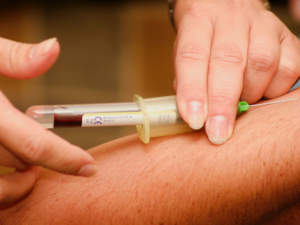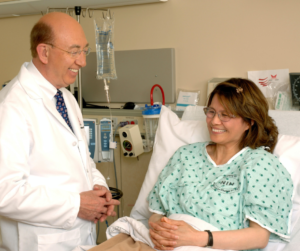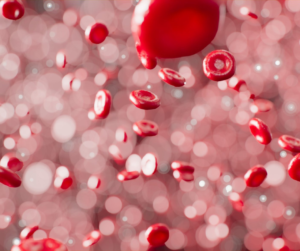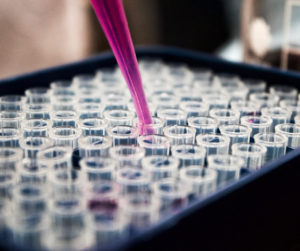Multiple myeloma (MM) is a neoplasm characterized by the clonal proliferation of plasma cells that remains an incurable disease. The treatment of relapsed or relapsed/refractory MM continues to be a challenge despite numerous therapeutic advances. B-cell maturation antigen (BCMA) is a cell-surface receptor that is expressed on multiple myeloma cells, but is absent on naïve or memory b-cells, thereby making it a suitable target in MM. Belantamab mafodotin is an anti-BCMA IgG1 monoclonal antibody conjugated to a microtubule-disrupting agent (MMAF). DREAMM-2 was a two arm, randomized, open-label, phase 2 study evaluating the safety and efficacy of belantamab mafodotin in patients with relapsed or refractory MM.
What patient population was eligible for inclusion in the DREAMM-2 trial?
Eligible patients were those with relapsed or refractory disease confirmed histologically or cytologically according to International Myeloma Working Group (IMWG) criteria; aged ≥18 year; an Eastern Cooperative Oncology Group (ECOG) of 0-2, having undergone autologous stem cell transplant (>100 days before enrollment) or were considered transplant ineligible; disease progression on or after receiving three or more previous lines of anti-myeloma therapy; adequate organ function; refractory to an immunomodulatory drug and proteasome inhibitor, and were refractory or intolerant (or both) to an anti-CD38 monoclonal antibody. Patients were randomly assigned (1:1) to receive belantamab mafodotin 2.5 mg/kg or 3.4 mg/kg every 3 weeks intravenously over 30 minutes or longer on day 1 of each cycle, until disease progression or unacceptable toxicity.
What were the key endpoints and assessments of the DREAMM-2 trial?
The primary endpoint of the study was the proportion of patients achieving an overall response, defined as the percentage of patients with confirmed partial response or better. Key secondary endpoints included duration of response, time to response, progression-free survival, overall survival, proportion of patients achieving clinical benefit (minimal response or better), and safety (adverse events, serious adverse events, and adverse events of special interest, which included thrombocytopenia, infusion-related reactions, and keratopathy).
What were the efficacy results of the DREAMM-2 trial?
196 patients were randomly assigned to the 2.5 mg/kg (n=97) and 3.4 mg/kg (n=99) cohorts and included in the intention-to-treat population. Baseline characteristics between the two cohorts were well matched and represented by ISS stage III disease, extramedullary disease, and high-risk cytogenetics. 30 (31%) of 97 patients in the 2.5 mg/kg cohort and 34 (34%) of 99 patients in the 3.4 mg/kg cohort achieved an overall response. 33 (34%) of 97 patients in the 2.5 mg/kg cohort and 39 (39%) of 99 patients in the 3.4 mg/kg cohort achieved a clinical benefit (minimal response or better).. Median progression-free survival was 2.9 months in the 2.5 mg/kg cohort and 4.9 months in the 3.4 mg/kg cohort.
What were the safety results of the DREAMM-2 trial?
For the safety analysis, 194 patients (n=95 in 2.5 mg/kg and n=99 in the 3.4 mg/kg) were included for evaluation. Overall, 93 (98%) of the 95 patients in the 2.5 mg/kg cohort and 99 (100%) of 99 patients in the 3.4 mg/kg cohort had at least one adverse event. The most common grade 3-4 adverse events in the safety population were keratopathy (in 26 [27%] of 95 patients in the 2.5 mg/kg cohort and 21 [21%] of the 99 patients in the 3.4 mg/kg cohort), thrombocytopenia (in 19 [20%] of 95 patients and 33 [33%] of 99 patients), anemia (19 [20%] of 95 patients and 25 [25%] of 99 patients). Among patients with infusion-related reactions, events were predominately grade 1-2 (in 17 [18%] of 95 patients in the 2.5 mg/kg cohort and 15 [15%] of 99 patients in the 3.4 mg/kg cohort) and most occurred with the first infusion.
What is the belantamab mafodotin Risk Evaluation and Mitigation Strategy (REMS) program?
Belantamab mafodotin carries a black box warning for ocular toxicity. In clinical trials, belantamab mafodotin caused changes in the corneal epithelium resulting in changes in vision, including severe vision loss and corneal ulcer, and symptoms, such as blurred vision and dry eyes. Conduct ophthalmic exams at baseline, prior to each dose, and promptly for worsening symptoms. The clinical team must certify within the REMS portal that ophthalmic exams are completed within 14 days of each dose. Advise patients to use preservative-free lubricant eye drops at least 4 times a day starting with the first infusion and continuing until the end of treatment.
Are corticosteroid eye drops more efficacious for the prevention of keratopathy?
In an ocular sub study within the DREAMM-2 trial, corticosteroid eye drops were not found to show a significant difference in the incidence of grade 3 keratopathy events and are not routinely recommended for prevention of keratopathy events.
What dosage of belantamab mafodotin is recommended for use?
The 2.5 mg/kg dose was selected as the recommended dose for future studies on the basis of its similar anti-myeloma activity with a more favorable safety profile when compared with the 3.4 mg/kg
Based on the efficacy and safety data of belantamab mafodotin, what is the current US Food and Drug Administration (FDA) indication for use?
Belantamab mafodotin is indicated for the treatment of adult patients with relapsed or refractory multiple myeloma who have received at least four prior therapies including an anti-CD38 monoclonal antibody, a proteasome inhibitor, and an immunomodulatory agent.
References:
- Lonial S, et al. Belantamab mafodotin for relapsed or refractory multiple myeloma (DREAMM-2): a two arm, randomized, open-label, phase 2 study. Lancet Oncol 2020: 21: 207-21
- Multiple Myeloma. NCCN Clinical Practice Guidelines in Oncology. Version 7.2021.
- BLENREP® (belantamab mafodotin) [package insert]. Research Triangle Park, NC. GlaxoSmithKline, 2020.

Adam Kahleifeh, PharmD
PGY2 Oncology Pharmacy Resident at Memorial Sloan Kettering Cancer Center







